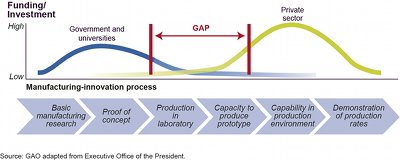
The forum's participants described nanomanufacturing as a future megatrend that will potentially match or surpass the digital revolution's effect on society and the economy. They anticipated further scientific breakthroughs that will fuel new engineering developments; continued movement into the manufacturing sector; and more intense international competition.
Although limited data on international investments made comparisons difficult, participants viewed the U.S. as likely leading in nanotechnology research and development (R&D) today. At the same time, they identified several challenges to U.S. competitiveness in nanomanufacturing, such as inadequate U.S. participation and leadership in international standard setting; the lack of a national vision for a U.S. nanomanufacturing capability; some competitor nations' aggressive actions and potential investments; and funding or investment gaps in the United States (illustrated in the figure, below), which may hamper U.S. innovators' attempts to transition nanotechnology from R&D to full-scale manufacturing.

Participants outlined three approaches that might be viewed as alternative ways to address these challenges--or used together: (1) strengthen U.S. innovation by updating current innovation-related policies and programs, (2) promote U.S. innovation in manufacturing through public-private partnerships, and (3) design a strategy for attaining a holistic vision for U.S. nanomanufacturing. Participants who represented a range of perspectives on environmental, health, and safety (EHS) issues also noted that significant research is needed to understand the risks associated with nanomaterials. As such, multiple participants advocated a collaborative effort, in which nanotechnology stakeholders create an EHS framework, including developing standards for measurement and nomenclature, to help assess and address these risks.
Finally, participants advocated both maintaining R&D support and considering ways to address the challenges outlined above. Justification of further steps might be based on their potential for improving (1) international data on nanotechnology investments, (2) international standard setting for nanomanufacturing and U.S. participation, (3) U.S. ability to maintain or enhance competitiveness, and (4) U.S. and international efforts to address EHS issues.
Why GAO Convened This Forum
Nanotechnology has been defined as the control or restructuring of matter at the atomic and molecular levels in the size range of about 1-100 nanometers (nm); 100 nm is about 1/1000th the width of a hair.
The U.S. National Nanotechnology Initiative (NNI), begun in 2001 and focusing primarily on R&D, represents a cumulative investment of almost $20 billion, including the request for fiscal year 2014. As research continues and other nations increasingly invest in R&D, nanotechnology is moving from the laboratory to commercial markets, mass manufacturing, and the global marketplace--a trend with potential future import that some compare to history's introduction of technologies with major economic and societal impact, such as plastics and even electricity. Today, burgeoning markets, innovation systems, and nanomanufacturing activities are increasingly competitive in a global context--and the potential EHS effects of nanomanufacturing remain largely unknown.
At the July 2013 forum, participants from industry, government, and academia discussed the future of nanomanufacturing; investments in nanotechnology R&D and challenges to U.S. competitiveness; ways to enhance U.S. competitiveness; and EHS concerns. Participants reviewed a summary of forum discussions, and two experts (who did not attend the forum) independently reviewed a draft of this report. Their comments were incorporated in this report as appropriate.
For more information, contact Timothy Persons, Chief Scientist, at (202) 512-6412 or personst@gao.gov.
View Full Report (PDF, 125 pages)
